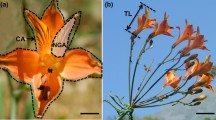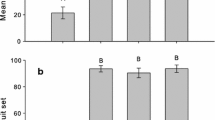Abstract
The rate of pollen exchange within and among flowers may depend on pollinator attraction traits such as floral display size and flowering plant density. Variations in these traits may influence pollinator movements, pollen receipt, and seed number. To assess how floral display size and flowering plant density affect parameters of pollinator visitation rate, pollen receipt per flower, seed number per fruit and the between-plant pollinator movements, we studied the self-incompatible plant, Nierembergia linariifolia. Per-flower pollinator visitation rate and bout length increased linearly with increasing floral display size. Pollen receipt per flower increased linearly with increasing flowering plant density. For seed number per fruit, a polynomial model describing an increased seed number per fruit at low density and a decreased seed number per fruit at high density provided a significant fit. Per-flower pollinator visitation rate was not associated with pollen receipt per flower and seed number per fruit. Bees visited plants located near to the center of the population more frequently than plants located at the periphery. Increases in both floral display size and flowering plant density led to an increased chance of a plant being chosen as the center of the pollinator foraging area. These results suggest that even though large floral displays and high flowering plant density are traits that attract more pollinators, they may also reduce potential mate diversity by restricting pollen movement to conspecific mates that are closely located.




Similar content being viewed by others
References
Andersson S (1988) Size-dependent pollination efficiency in Anchusa officinalis (Boraginaceae): causes and consequences. Oecologia 76:125–150
Andersson S (2005) Floral costs in Nigella sativa (Ranunculaceae): compensatory responses to perianth removal. Am J Bot 92:279–283
Andersson S (2006) Experimental demonstration of floral allocation costs in Crepis tectorum. Can J Bot 84:904–909
Ashman T-L, Morgan MT (2004) Explaining phenotypic selection on plant attractive characters: male function, gender balance or ecological context? Proc R Soc B 271:553–559
Burns JG, Thomson JD (2006) A test of spatial memory and movement patterns of bumblebees at multiple spatial and temporal scales. Behav Ecol 17:48–55
Cabrera AL (1971) Fitogeografía de la República Argentina. Sociedad Argentina de Botánica, Buenos Aires
Cartar RV (2004) Resource-tracking by bumble bees: responses to plant-level differences in quality. Ecology 85:2764–2771
Cocucci AA (1991) Pollination biology of Nierembergia (Solanaceae). Plant Syst Evol 174:17–35
Cosacov A, Nattero J, Cocucci AA (2008) Variation of pollinator assemblages and pollen limitation in a locally specialized system: the oil producing Nierembergia linariifolia (Solanaceae). Ann Bot 102:723–734
de Jong TJ, Waser NM, Klinkhamer PGL (1993) Geitonogamy – the neglected side of selfing. Trends Ecol Evol 8:321–325
Dreisig H (1995) Ideal free distributions of nectar foraging bumblebees. Oikos 72:161–172
Duncan D, Nicotra AB, Wood JT, Cunningham SA (2004) Plant isolation reduces outcross pollen receipt in a partially self-compatible herb. J Ecol 92:977–985
Ehlers BK, Olesen JM, Ågren J (2002) Floral morphology and reproductive success in the orchid Epipactis helleborine: regional and local across-habitat variation. Plant Syst Evol 236:19–32
Elliot SE, Irwin RE (2009) Effects of flowering plant density on pollinator visitation, pollen receipt, and seed production in Delphinium barbeyi (Ranunculaceae). Am J Bot 96:912–919
Engel EC, Irwin RE (2003) Linking pollinator visitation rate and pollen receipt. Am J Bot 90:1612–1618
Galen C, Sherry RA, Carroll AB (1999) Are flowers physiological sinks or faucets? Costs and correlates of water use by flowers of Polemonium viscosum. Oecologia 118:461–470
García-Robledo C, Kattan G, Murcia C, Quintero-Marín P (2005) Equal and opposite effects of floral offer and spatial distribution on fruit production and predispersal seed predation in Xanthosoma daguense (Araceae). Biotropica 37:373–380
Ghazoul J, Shaanker RU (2004) Sex in space: pollination among spatially isolated plants. Biotropica 36:128–130
Grindeland JM, Sletvold N, Ims RA (2005) Effects of floral display size and plant density on pollinator visitation rate in a natural population of Digitalis purpurea. Func Ecol 19:383–390
Haig D, Westoby M (1988) On limits to seed production. Am Nat 131:757–759
Harder LD, Barrett SCH (1995) Mating cost of large floral displays in hermaphrodite plants. Nature 373:512–515
Harder LD, Barrett SCH (1996) Pollen dispersal and mating patterns in animal-pollinated plants. In: Lloyd DG, Barrett SCH (eds) Floral biology. Chapman and Hall, New York, pp 140–190
Hegland SJ, Boeke L (2006) Relationships between the density and diversity of floral resources and flower visitor activity in a temperate grassland community. Ecol Entomol 31:532–538
Holland JN, DeAngelis DL, Bronstein JL (2002) Population dynamics and mutualism: functional responses of benefits and costs. Am Nat 159:231–244
Johnson SD, Peter C, Nilsson LA, Ågren J (2003) Pollination success in a deceptive orchid is enhanced by co-occurring rewarding magnet plants. Ecology 84:2919–2927
Kacelnik A, Houston AI, Schmid-Hempel P (1986) Central place foraging in honey-bees. The effect of travel time and nectar flow on crop filling. Behav Ecol Sociobiol 19:19–24
Karron JD, Mitchell RJ, Holmquist KG, Bell JM, Funk B (2004) The influence of floral display size on selfing rates in Mimulus ringens. Heredity 92:242–248
Karron JD, Mitchell RJ, Bell JM (2006) Multiple pollinator visits to Mimulus ringens (Phrymaceae) flowers increase mate number and seed set within fruits. Am J Bot 93:1306–1312
Kearns CA, Inouye DW (1993) Techniques for pollination biologists. University Press of Colorado, Colorado
Klinkhamer PGL, de Jong TJ (1990) Effects of plant size, plant density and sex differential nectar reward on pollinator visitation in the protandrous Echium vulgare (Boraginaceae). Oikos 57:399–403
Klinkhamer PGL, de Jong TJ, de Bruyn GJ (1989) Plant size and pollinator visitation in Cynoglossum officinale. Oikos 54:201–204
Krebs CJ (1999) Ecological methodology, 2nd edn. Cummings, Menlo Park
Kunin WE (1993) Sex and the single mustard: population density and pollinator behavior effects on seed-set. Ecology 74:2145–2160
Kunin WE (1997) Population size and density effects in pollination: pollinator foraging and plant reproductive success in experimental arrays of Brassica kaber. J Ecol 85:225–234
Makino TT, Ohashi K, Sakai S (2007) How do floral display size and the density of surrounding flowers influence the likelihood of bumble bee revisitation to a plant? Func Ecol 21:87–95
Manning A (1956) Some aspects of the foraging behaviour of bumblebees. Behaviour 9:164–201
Maron JL, Crone E (2006) Herbivory: effects on plant abundance, distribution and population growth. Proc R Soc B 273:2575–2584
Mitchell RJ (1994) Effects of floral traits, pollinator visitation and plant size on Ipomopsis aggregata fruit production. Am Nat 143:870–889
Mitchell RJ, Karron JD, Holmquist KG, Bell JM (2004) The influence of Mimulus ringens floral display size on pollinator visitation patterns. Func Ecol 18:116–124
Mustajärvi K, Siikamäki P, Rytkönen S, Lammi A (2001) Consequences of plant population size and density for plant–pollinator interactions and plant performance. J Ecol 89:80–87
Nattero J, Cocucci A, Medel R (2010) Pollinator-mediated selection in a specialized pollination system: matches and mismatches across populations. J Evol Biol 23:1957–1968
Nielsen A, Ims RA (2000) Bumble bee pollination of the sticky catchfly in a fragmented agricultural landscape. Ecoscience 7:157–165
Ohashi K, Yahara T (1999) How long to stay on, and how often to visit a flowering plant? A model for foraging strategy when floral displays vary in size. Oikos 86:386–392
Ohashi K, Yahara T (2002) Visit larger displays but probe proportionally fewer flowers: counterintuitive behaviour of nectar-collecting bumble bees achieves an ideal free distribution. Func Ecol 16:492–503
Osborne JL, Williams IH (2001) Site constancy of bumble bees in an experimentally patchy habitat. Agric Ecosyst Environ 83:129–141
Osborne JL, Clark SJ, Morris RJ, Williams IH, Riley JR, Smith AD, Reynolds DR, Edwards AS (1999) A landscape-scale study of bumblebee foraging range and constancy, using harmonic radar. J Appl Ecol 36:519–533
Pettersson MW (1997) Solitary plants do as well as clumped ones in Silene uniflora (Caryophyllaceae). Ecography 20:375–382
Pyke GH (1979) Optimal foraging in bumblebees: rule of movement between flowers within inflorescences. Anim Behav 27:1167–1181
Richards AJ (1997) Plant breeding systems. Chapman and Hall, London
Ritland K (1991) A genetic approach to measuring pollen discounting in natural plant populations. Am Nat 138:1049–1057
Robertson AW, Macnair MR (1995) The effects of floral display size on pollinator service to individual flowers of Myosotis and Mimulus. Oikos 72:106–114
Sabat AM, Ackerman JD (1996) Fruit set in a deceptive orchid: the effect of flowering phenology, display size, and local floral abundance. Am J Bot 83:1181–1186
Sokal RR, Rohlf FJ (1995) Biometry, 3rd edn. WH Freeman, New York
Somanathan H, Borges RM (2004) Does neighborhood floral display matter? Fruit set in carpenter bee-pollinated Heferophragma quadriloculare and beetle-pollinated Lasiosiphon eriocephalus. Biotropica 36:139–147
Spigler RB, Chang SM (2008) Effects of plant abundance on reproductive success in the biennal Sabatia angularis (Gentianaceae): spatial scale matters. J Ecol 96:323–333
Steven JC, Rooney TP, Boyle OD, Waller DM (2003) Density-dependent pollinator visitation and self-incompatibility in upper Great Lakes populations of Trillium grandiflorum. J Torrey Bot Soc 130:23–29
Stout JC, Allen JA, Goulson D (1998) The influence of relative plant density and floral morphological complexity on the behaviour of bumblebees. Oecologia 117:543–550
Totland Ø (2001) Environment-dependent pollen limitation and selection on floral traits in an alpine species. Ecology 82:2233–2244
Vaughton G, Ramsey M (1998) Floral display, pollinator visitation and reproductive success in the dioecious perennial herb Wurmbea dioica (Liliaceae). Oecologia 115:93–101
Vaughton G, Ramsey M (2010) Floral emasculation reveals pollen quality limitation of seed output in Bulbine bulbosa (Asphodelaceae). Am J Bot 97:174–178
Waites AR, Ågren J (2004) Pollinator visitation, stigmatic pollen loads and among-population variation in seed set in Lythrum salicaria. J Ecol 92:512–526
Williams NM, Thomson JD (1998) Trapline foraging by bumble bees: III. Temporal patterns of visitation and foraging success at single plants. Behav Ecol 9:612–621
Willson MF, Price BJ (1977) The evolution of inflorescence size in Asclepias (Asclepiadaceae). Evolution 31:495–511
Acknowledgments
We are grateful to M. Calumi and C. Lazarte who assisted us during the field work. J.N. and A.A.C. are fellow researchers from CONICET. We would also thank two anonymous reviewers for their useful comments. This study was funded by Consejo Nacional de Investigaciones Científicas y Técnicas (PIP 5174) and Secretaría de Ciencia y Técnica Universidad Nacional de Córdoba (197/05).
Author information
Authors and Affiliations
Corresponding author
Rights and permissions
About this article
Cite this article
Nattero, J., Malerba, R., Medel, R. et al. Factors affecting pollinator movement and plant fitness in a specialized pollination system. Plant Syst Evol 296, 77–85 (2011). https://doi.org/10.1007/s00606-011-0477-4
Received:
Accepted:
Published:
Issue Date:
DOI: https://doi.org/10.1007/s00606-011-0477-4




